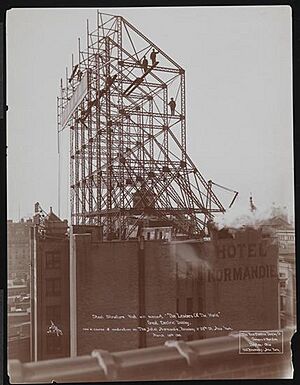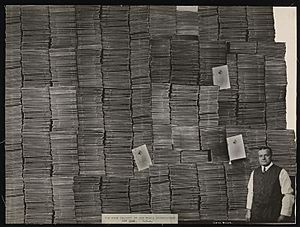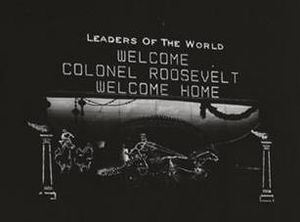Leaders of the World facts for kids
Imagine a giant, flashing billboard in New York City over 100 years ago! That was the Leaders of the World sign. It lit up the city from 1910 to 1912. When it was built, it was one of the biggest electric signs in New York. It showed an exciting animated scene of a Roman chariot race. It also displayed messages for companies. The sign started working on July 19, 1910. Sadly, a big storm destroyed it on February 22, 1912.
Building the Giant Sign
The Leaders of the World sign was built by the Rice Electric Display Company. This company was from Dayton, Ohio. Workers put the sign on top of the Hotel Normandie. This hotel was on Broadway and 38th Street, close to Herald Square.
It took about 90 days, or three months, to build the sign. It first lit up on the evening of July 19, 1910. So many people came to see it that the police had trouble controlling the crowd!
This huge sign used about 20,000 electric light bulbs. It needed a lot of power, about 600 horsepower. It also had more than 95 miles of electrical wire. There were 70,000 electrical connections! The whole sign weighed 3 tons, which is like the weight of two small cars. When it was built, it had ten times more light bulbs than any other electric sign on Broadway.
The sign was built in pieces away from New York City. It took eight railroad cars to bring all the parts to the city.
When the sign was ready, Elwood E. Rice, who helped create it, threw a party. The party was on the roof of the Marlborough Hotel. This hotel was just two blocks away and had a great view of the new sign. The party had an orchestra and a buffet lunch. Only invited guests could attend.
What the Sign Looked Like
The most exciting part of the sign was an animated scene. It showed a Roman chariot race. This scene would play over and over again every 30 seconds. The sign used flashing lights to make it look like the chariots, horses, and drivers were moving. The crowd in the stadium seemed to move in the opposite direction.
At the very top of the sign, there was a special display. This part could show messages for companies. It had three lines, and each line could fit 18 characters. Each letter was very tall, about 1.3 meters (over 4 feet) high.
In 1911, there was a contest for the sign. People could send in "snappy catch phrases or slogans" for advertisers to use. This contest was advertised in 18 cities, even in Paris! About 500,000 people entered the contest. They competed for $15,000 in cash prizes.
When it was built, the Leaders of the World sign was one of the biggest animated signs ever. It was 72 feet tall and 90 feet wide. The horses in the chariot race scene were huge! They were 20 feet high and 40 feet long. Their wheels were 8 feet across. These giant sizes made them look normal when people saw them from the street.
The sign used different kinds of incandescent light bulbs. Some were small, and others were very bright. About 2,750 electrical switches controlled all the lights. Two 10-horsepower motors were needed to operate these switches. The sign had no moving parts. The amazing motion was created just by lights flashing very quickly. For example, one horse had eight sets of lights for its legs. These lights flashed so fast that your eyes saw continuous motion.
Destroyed by a Storm
The Leaders of the World sign was destroyed by a huge storm. This record-setting storm hit New York on February 22, 1912. The strong winds broke the sign into two pieces. The top part was left hanging dangerously. Because of this, the Fire Department ordered the rest of the sign to be taken down.
Reports said that the winds were as strong as 110 miles per hour. The Monthly Weather Review even noted an extreme wind speed of 120 miles per hour. They said that "The largest damage was to signs and plate-glass windows."
Images for kids







